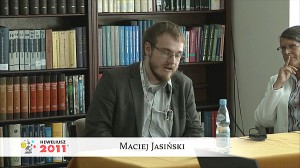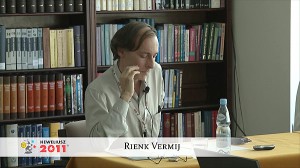Konferencja Hevelius 2011 – Sesja 6 – Pietro Daniel Omodeo
 Temat: Abraham von Franckenberg i Jan Heweliusz: siedemnastowieczna astronomia w Gdańsku a Giordano Bruno i Galileusz.
Temat: Abraham von Franckenberg i Jan Heweliusz: siedemnastowieczna astronomia w Gdańsku a Giordano Bruno i Galileusz.
W wystąpieniu porównane zostaną dwa podejścia do astronomii, wynikające z kosmologicznych rozważań, zaprezentowanych w dziełach Oculus Sidereus (Gdańsk 1644) Franckenberga i Selenographia (Gdańsk 1647) Heweliusza. Śląski arystokrata Abraham von Franckenberg (1593-1652), znany przede wszystkim jako uczeń, biograf i wydawca pism mistyka Jacoba Böhme, przebywał w Gdańsku w latach 1642-1649, gdzie zaprzyjaźnił się z Janem Heweliuszem. W tym okresie Franckenberg opublikował swój traktat kosmologiczny Oculus Sidereus, zainspirowany lekturą De immenso et innumerabilis (Frankfurt nad Menem 1591) Giordana Bruna; fragmenty książki Bruna zostały dołączone jako dodatek. Za włoskim filozofem Franckenberg uznawał planetarny kopernikanizm, nieskończoność przestrzeni, kosmologiczną jednorodność, wielość światów i uniwersalny witalizm. Co więcej, wierzył, że natura jest omni-varia omnium mater (Oculus, k. C1r), przeniknięta boskim życiem (ibid., k. C2v). Podążając śladami Kopernika, Campanelli, Bruna i Patriziego, przyjmował istnienie fundamentalnej zgodności między kosmologią a teologią. Donosił także o obserwacjach nieba, wykonywanych wspólnie z Panem Janem Heweliuszem (ibid., k. C3 i E1r) w celu potwierdzenia swych poglądów. Trzy lata później Heweliusz wydał swoją słynną Selenografíę, która zawiera okolicznościowy poemat Franckenberga (Selenographia, k. ****2r). Stosunek Heweliusza do astronomii zawdzięcza więcej trzeźwemu podejściu Galileusza niż spekulatywnemu duchowi Bruna i innych filozofów epoki renesansu. Bezpośrednia wzmianka o Brunie pojawia się tylko w związku z problemem nieskończoności przestrzeni, którą to tezę Heweliusz jest skłonny odrzucić (Selenographia, s. 153). Niemniej kilka poglądów Heweliusza, sformułowanych w części kosmologicznej (rozdz. VII, s. 152-204), pozostaje w zgodzie z Brunem: kosmologiczna jednorodność (uznawana także przez Galileusza), płynność materii niebieskiej (Tycho Brahe) i życie pozaziemskie. Można przypuszczać, że Franckenberg i Heweliusz dyskutowali o kwestiach kosmologicznych i dotyczących natury, wywierając na siebie wpływ pomimo różnic w podejściu do astronomii. Potwierdzają to fragmenty poświęcone Heweliuszowi i jego dziełu w korespondencji Franckenberga.
materiał w języku angielskim
Pietro Daniel Omodeo (Max Planck Institute for the History of Science, Berlin):
Abraham von Franckenberg and Johannes Hevelius: The Brunian and the Galileaian Spirit of Seventeenth Century Astronomy in Judgments of Hevelius’s Gdansk (Abraham von Franckenberg and Johannes Hevelius: The Brunian and the Galileaian Spirit of Seventeenth Century Astronomy in Gdansk)
This paper is a comparison of Franckenberg’s and Hevelius’s approaches to astronomy as they result from their cosmological considerations in Oculus Sidereus (Gdańsk, 1644) and Selenographia (Gdańsk, 1647). The Silesian aristocrat Abraham von Franckenberg (1593-1652), who is mainly known as a pupil, a biographer and an editor of the mystic Jacob Bohrne, sojourned in Gdańsk from 1642 to 1649, were he became a friend of Johannes Hevelius. In this period, he published a cosmological book, Oculus Sidereus (Gdańsk, 1644), explicitly inspired by Bruno’s De immenso et innumerabilis (Frankfurt am Main 1591), excerpts of which he inserted as an appendix. Franckenberg owed much to the Italian philosopher since he supported planetary Copemicanism, space infinity, cosmological homogeneity, the plurality of worlds, and universal vitalism. Moreover, he conceived of nature as the omni-varia omnium mater (Oculus, f. C1r) permeated by divine life (ibid., f. C2v). Following in the footsteps of Copernicus, Campanella, Bruno and Patrizi, he claimed the fundamental agreement between cosmology and theology. He also reported on celestial observations accomplished together with Dominus Johannes Hevelke (ibid., f. C3 and E1r), in order to corroborate his views. Three years later, Hevelius printed his renowned Selenographia, which includes a laudatory poem by Franckenberg (Selenographia, f. ****2r). Hevelius’s approach to astronomy owes much more to the sobriety of Galilei than to the speculative spirit of Bruno and other Renaissance philosophers. Bruno is explicitly mentioned only relative to space infinity, a philosophical thesis which Hevelius inclines to reject (Selenographia, p. 153). Nonetheless, several views of his, exposed in the cosmological section (chap. VII, pp. 152-204), are in agreement with Bruno: cosmological homogeneity (also by Galilei), heavenly fluidity (also by Brahe), universal vitalism, the soul of the celestial bodies, the anima mundi (with reference to Komensky), and extraterrestrial life. One may assume that, concerning cosmological and natural issues, Franckenberg and Hevelius exchanged ideas and influenced each other, in spite of their different attitudes toward astronomy. This hypotheses is confirmed by several passages on Hevelius and his work in Franckenberg’s correspondence.


